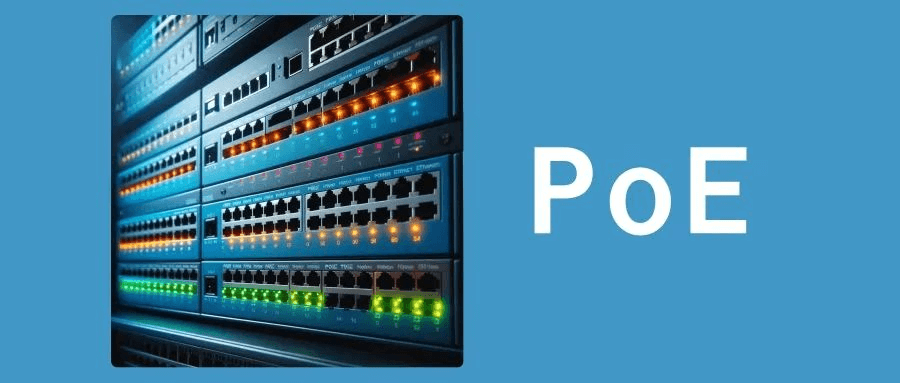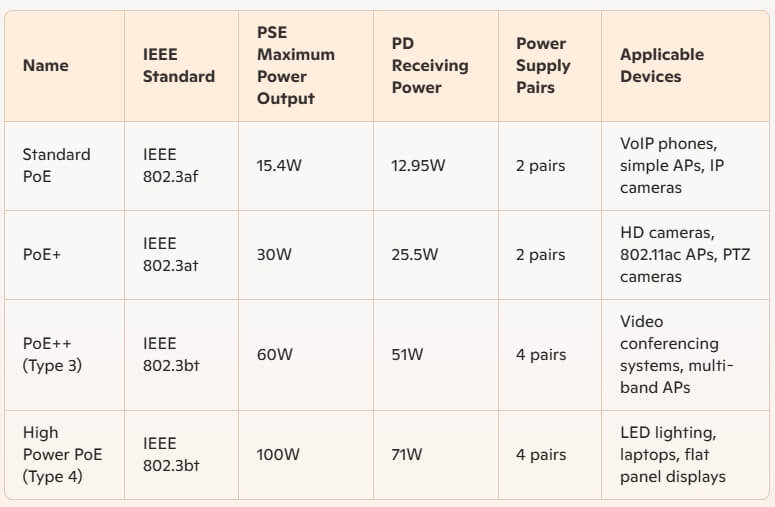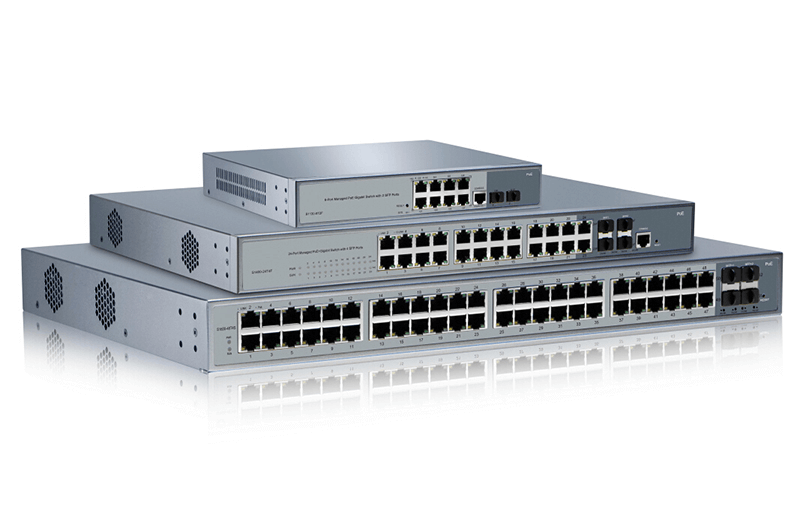In modern network infrastructure, Power over Ethernet (PoE) technology has become increasingly important. PoE technology allows both data and power to be transmitted through a single Ethernet cable, greatly simplifying the installation and management of devices, especially IP cameras, VoIP phones, and wireless access points (WAPs).

How PoE Works
PoE technology provides power to network devices through Ethernet cables. The network devices consist of Power Sourcing Equipment (PSE) and Powered Devices (PD). PSE, typically a PoE switch or PoE injector, supplies power to PDs. PDs are devices that receive power from PSE, such as wireless access points, IP cameras, and VoIP phones.
A key advantage of PoE technology is its ability to transmit power through standard Ethernet cables without needing additional power cables. This reduces wiring complexity, installation costs, and maintenance requirements. The power transmission of PoE technology follows several standards set by the IEEE to ensure compatibility and safety among various devices.
Overview of PoE Standards
PoE standards, primarily defined by the IEEE, range from low to high power levels. These standards specify the maximum power that PSE can transmit and the power that PD can receive. The widely used PoE standards include:
- IEEE 802.3af (Standard PoE)
- IEEE 802.3at (PoE+)
- IEEE 802.3bt (PoE++ or High Power PoE)
Each standard offers different power transmission capabilities and application scenarios, requiring network designers to choose the appropriate PoE standard based on device power needs.
IEEE 802.3af Standard (Standard PoE)
- Voltage Range: 44-57V
- Maximum Current: 350mA
- PSE Maximum Power Output: 15.4W
- PD Receiving Power: 12.95W
Published in 2003, IEEE 802.3af is the first formal PoE standard. It allows PSE to provide up to 15.4W of power, with PDs receiving up to 12.95W after accounting for cable transmission loss. This standard is suitable for low-power devices like IP phones, simple wireless access points, and static IP cameras. Despite being the earliest PoE standard, IEEE 802.3af remains widely used for lower-power devices. However, as network devices have become more complex and power-hungry, the need for higher power led to the development of the IEEE 802.3at standard.
IEEE 802.3at Standard (PoE+)
- Voltage Range: 50-57V
- Maximum Current: 600mA
- PSE Maximum Power Output: 30W
- PD Receiving Power: 25.5W
IEEE 802.3at, also known as PoE+, was released in 2009 as an upgrade to IEEE 802.3af. PoE+ is backward compatible with 802.3af devices but significantly increases power output, providing up to 30W of power and ensuring that PDs receive at least 25.5W. The PoE+ standard is primarily used for higher-power devices, such as high-definition IP cameras, wireless access points (especially those supporting 802.11ac), PTZ (pan-tilt-zoom) cameras, and video conferencing systems. The introduction of PoE+ marked a new phase in PoE technology, offering reliable power support for more feature-rich and power-demanding network devices and expanding PoE applications.
IEEE 802.3bt Standard (PoE++ or High Power PoE)
With the growing power demands of network devices, IEEE introduced the IEEE 802.3bt standard in 2018, also known as PoE++ or High Power PoE. This standard introduces two new types: Type 3 (PoE++) and Type 4 (High Power PoE), which can transmit power over four pairs of Ethernet cables, providing higher power output.
Type 3 (PoE++)
- Voltage Range: 50-57V
- PSE Maximum Power Output: 60W
- PD Receiving Power: 51W
Type 3, also known as PoE++, allows PSE to supply up to 60W of power, with PDs receiving up to 51W. This standard is suitable for high-power devices such as high-definition video conferencing systems, multi-band wireless access points, and advanced camera equipment. Type 3 is backward compatible with IEEE 802.3af and 802.3at standards, enabling seamless integration in mixed network environments.
Type 4 (High Power PoE)
- Voltage Range: 50-57V
- PSE Maximum Power Output: 100W
- PD Receiving Power: 71W
Type 4 is currently the highest power PoE standard, providing up to 100W of power output, with PDs receiving up to 71W. This standard is intended for high-power devices like LED lighting, flat panel displays, laptops, and certain industrial equipment. High Power PoE significantly reduces wiring complexity by allowing devices to receive sufficient power through a single Ethernet cable.
PoE Standards and Power Comparison Table


Selecting Appropriate PoE Devices
In practical applications, choosing the right PoE devices requires a comprehensive assessment of network needs and device power consumption. The power budget, port count of PoE sourcing equipment, and the power requirements of powered devices need detailed calculations. For example, if a network deploys 48 VoIP phones, each requiring 12.95W, a 48-port PoE switch must have a total power budget of at least 622W (12.95W × 48). For PoE+ devices, each requiring 25.5W, the same number of devices would need a minimum power budget of 1,224W.
For high-power devices such as multi-band wireless access points and high-definition video conferencing systems, PoE++ or High Power PoE devices should be chosen to ensure sufficient power.
Power Management of PoE Switches
Modern PoE switches often come with intelligent power management features that automatically detect the power requirements of connected devices and allocate power accordingly. For instance, if a device needs only 5W of power, the switch will adjust the output to avoid power wastage. Additionally, PoE switches can prioritize power for critical devices, ensuring efficient network operation.
